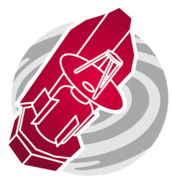
Back Herschel-ruimtesterrewag Afrikaans مرصد هيرشل الفضائي Arabic Herşel Kosmik Teleskopu Azerbaijani Хершел (космическа обсерватория) Bulgarian Observatori espacial Herschel Catalan Herschelova vesmírná observatoř Czech Herschel-Weltraumteleskop German Kosmoteleskopo Herschel Esperanto Herschel (observatorio espacial) Spanish Herscheli kosmoseteleskoop Estonian
 Model of the Herschel Observatory | |||||||||
| Names | Far Infrared and Submillimetre Telescope | ||||||||
|---|---|---|---|---|---|---|---|---|---|
| Mission type | Space telescope | ||||||||
| Operator | ESA / NASA | ||||||||
| COSPAR ID | 2009-026K | ||||||||
| SATCAT no. | 34937 | ||||||||
| Website | www | ||||||||
| Mission duration | Planned: 3 years Final: 4 years, 1 month, 2 days[1] | ||||||||
| Spacecraft properties | |||||||||
| Manufacturer | Thales Alenia Space | ||||||||
| Launch mass | 3,400 kg (7,500 lb)[2] | ||||||||
| Payload mass | Telescope: 315 kg (694 lb)[2] | ||||||||
| Dimensions | 7.5 m × 4.0 m (25 ft × 13 ft)[2] | ||||||||
| Power | 1 kW | ||||||||
| Start of mission | |||||||||
| Launch date | 14 May 2009, 13:12:02 UTC | ||||||||
| Rocket | Ariane 5 ECA | ||||||||
| Launch site | Guiana Space Centre, French Guiana | ||||||||
| Contractor | Arianespace | ||||||||
| End of mission | |||||||||
| Disposal | Decommissioned | ||||||||
| Deactivated | 17 June 2013, 12:25 UTC[3] | ||||||||
| Orbital parameters | |||||||||
| Reference system | L2 point (1,500,000 km / 930,000 mi) | ||||||||
| Regime | Lissajous | ||||||||
| Main telescope | |||||||||
| Type | Ritchey–Chrétien | ||||||||
| Diameter | 3.5 m (11 ft) f/0.5 (primary mirror)[4] | ||||||||
| Focal length | 28.5 m (94 ft) f/8.7[4] | ||||||||
| Collecting area | 9.6 m2 (103 sq ft) | ||||||||
| Wavelengths | 55 to 672 μm (far infrared) | ||||||||
| |||||||||
 ESA astrophysics insignia for Herschel | |||||||||
The Herschel Space Observatory was a space observatory built and operated by the European Space Agency (ESA). It was active from 2009 to 2013, and was the largest infrared telescope ever launched until the launch of the James Webb Space Telescope in 2021.[5] Herschel carries a 3.5-metre (11.5 ft) mirror[5][6][7][8] and instruments sensitive to the far infrared and submillimetre wavebands (55–672 μm). Herschel was the fourth and final cornerstone mission in the Horizon 2000 programme, following SOHO/Cluster II, XMM-Newton and Rosetta.
The observatory was carried into orbit by an Ariane 5 in May 2009, reaching the second Lagrangian point (L2) of the Earth–Sun system, 1,500,000 kilometres (930,000 mi) from Earth, about two months later. Herschel is named after Sir William Herschel, the discoverer of the infrared spectrum and planet Uranus, and his sister and collaborator Caroline Herschel.[9]
The observatory was capable of seeing the coldest and dustiest objects in space; for example, cool cocoons where stars form and dusty galaxies just starting to bulk up with new stars.[10] The observatory sifted through star-forming clouds—the "slow cookers" of star ingredients—to trace the path by which potentially life-forming molecules, such as water, form.
The telescope's lifespan was governed by the amount of coolant available for its instruments; when that coolant ran out, the instruments would stop functioning correctly. At the time of its launch, operations were estimated to last 3.5 years (to around the end of 2012).[11] It continued to operate until 29 April 2013 15:20 UTC, when Herschel ran out of coolant.[12]
NASA was a partner in the Herschel mission, with US participants contributing to the mission; providing mission-enabling instrument technology and sponsoring the NASA Herschel Science Center (NHSC) at the Infrared Processing and Analysis Center and the Herschel Data Search at the Infrared Science Archive.[13]
- ^ Amos, Jonathan (29 April 2013). "Herschel space telescope finishes mission". BBC News. Retrieved 4 May 2015.
- ^ a b c "Herschel: Vital stats". European Space Agency. Retrieved 4 May 2015.
- ^ Amos, Jonathan (17 June 2013). "Herschel telescope switched off". BBC News. Retrieved 17 June 2013.
- ^ a b "The Herschel Space Observatory". Swiss Physical Society. March 2009. Archived from the original on 21 November 2015. Retrieved 4 May 2015.
- ^ a b "ESA launches Herschel and Planck space telescopes". Aerospaceguide. Retrieved 3 December 2010.
- ^ "ESA launches Herschel and Planck space telescopes". Euronews. Archived from the original on 28 February 2010. Retrieved 3 December 2010.
- ^ Amos, Jonathan (14 June 2009). "ESA launches Herschel and Planck space telescopes". BBC. Retrieved 3 December 2010.
- ^ "Herschel closes its eyes on the Universe". ESA. Retrieved 29 April 2013.
- ^ "Revealing the invisible: Caroline and William Herschel". ESA. 18 June 2000. Retrieved 22 July 2010.
- ^ ESA Science & Technology: Herschel. Retrieved on 28 July 2010
- ^ "Infrared Space Astronomy: Herschel". Max-Planck-Institut für Astronomie. Archived from the original on 29 June 2009. Retrieved 29 June 2009.
- ^ Amos, Jonathan (29 April 2013). "Herschel space telescope finishes mission". BBC News. Retrieved 29 April 2013.
- ^ "NSSDC Spacecraft Details: Herschel Space Observatory". NASA. Retrieved 3 July 2010.